
History of the ambulance
Encyclopedia
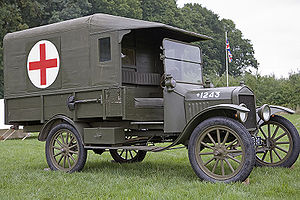
Ambulance
An ambulance is a vehicle for transportation of sick or injured people to, from or between places of treatment for an illness or injury, and in some instances will also provide out of hospital medical care to the patient...
begins in ancient times, with the use of carts to transport incurable patients by force. Ambulances were first used for emergency transport in 1487 by the Spanish, and civilian variants were put into operation in the 1830s. Advances in technology throughout the 19th and 20th centuries led to the modern self-powered ambulances.
Early patient transport
There is evidence of forced transport of those with psychiatric problems or leprosyLeprosy
Leprosy or Hansen's disease is a chronic disease caused by the bacteria Mycobacterium leprae and Mycobacterium lepromatosis. Named after physician Gerhard Armauer Hansen, leprosy is primarily a granulomatous disease of the peripheral nerves and mucosa of the upper respiratory tract; skin lesions...
in ancient times. The earliest record of such an ambulance was probably a hammock based cart constructed around 900 AD by the Anglo-Saxons
Anglo-Saxons
Anglo-Saxon is a term used by historians to designate the Germanic tribes who invaded and settled the south and east of Great Britain beginning in the early 5th century AD, and the period from their creation of the English nation to the Norman conquest. The Anglo-Saxon Era denotes the period of...
.
During the Muslim conquests
Muslim conquests
Muslim conquests also referred to as the Islamic conquests or Arab conquests, began with the Islamic prophet Muhammad. He established a new unified polity in the Arabian Peninsula which under the subsequent Rashidun and Umayyad Caliphates saw a century of rapid expansion of Muslim power.They...
of the 7th century, the Muslim armies
Rashidun army
The Rashidun Caliphate Army or Rashidun army was the primary military body of the Rashidun Caliphate's armed forces during the Muslim conquests of the 7th century, serving alongside the Rashidun Navy...
during the time of Muhammad
Muhammad
Muhammad |ligature]] at U+FDF4 ;Arabic pronunciation varies regionally; the first vowel ranges from ~~; the second and the last vowel: ~~~. There are dialects which have no stress. In Egypt, it is pronounced not in religious contexts...
were reported to have had a mobile dispensary
Dispensary
A dispensary is an office in a school, hospital or other organization that dispenses medications and medical supplies. In a traditional dispensary set-up a pharmacist dispenses medication as per prescription or order form....
following them for the treatment of soldier
Soldier
A soldier is a member of the land component of national armed forces; whereas a soldier hired for service in a foreign army would be termed a mercenary...
s on the battle
Battle
Generally, a battle is a conceptual component in the hierarchy of combat in warfare between two or more armed forces, or combatants. In a battle, each combatant will seek to defeat the others, with defeat determined by the conditions of a military campaign...
field. In particular, a Muslim woman
Women in Islam
The study of women in Islam investigates the role of women within the religion of Islam. The complex relationship between women and Islam is defined by Islamic texts, the history and culture of the Muslim world...
called Amina bint Qais at the age of seventeen was the youngest woman to lead a medical team in one of these early battles. This feature was incorporated into the Bimaristan
Bimaristan
Bimaristan is a Persian word meaning hospital, with Bimar- from Middle Persian of vīmār or vemār, meaning "sick" plus -stan as location and place suffix...
hospital institution from the 8th century. By the 10th century, doctors were often assigned to mobile medical teams to treat patients outside of the hospital. For example, Ali Ibn Isa assigned Sinan ibn Thabit
Sinan ibn Thabit
Sinan ibn Thabit ibn Qurra سنان بن ثابت بن قرة ) was an ethnic Mandean physician and a Sabian who later converted to Islam. He was the son of Thabit ibn Qurra and the father of Ibrahim ibn Sinan.- References :...
the task of sending doctors to treat the inmates of prisons, who were likely to have diseases "in view of their numbers and the harshness of their whereabouts." He also asked Sinan to send a mobile medical team to tour the countryside of southern Iraq
Iraq
Iraq ; officially the Republic of Iraq is a country in Western Asia spanning most of the northwestern end of the Zagros mountain range, the eastern part of the Syrian Desert and the northern part of the Arabian Desert....
and treat the residents there, whether Muslim or non-Muslim, as well as the cattle.
During the Crusades
Crusades
The Crusades were a series of religious wars, blessed by the Pope and the Catholic Church with the main goal of restoring Christian access to the holy places in and near Jerusalem...
of the 11th century, the Knights of St John set up hospitals to treat pilgrims wounded in their battles in the 'holy land', although there is no clear evidence to suggest how the wounded made their way to these hospitals.
The Normans
Normans
The Normans were the people who gave their name to Normandy, a region in northern France. They were descended from Norse Viking conquerors of the territory and the native population of Frankish and Gallo-Roman stock...
used a litter suspended between horse
Horse
The horse is one of two extant subspecies of Equus ferus, or the wild horse. It is a single-hooved mammal belonging to the taxonomic family Equidae. The horse has evolved over the past 45 to 55 million years from a small multi-toed creature into the large, single-toed animal of today...
s on two poles. Variations on the horse litter and horse-drawn wagons were used from then right up to the 20th century.
Early battlefield treatment
The first record of ambulances being used for emergency purposes was the use by Queen Isabella of Spain, in 1487. The Spanish army of the time was treated extremely well and attracted volunteers from across the continent, and part of this was the first military hospitals or 'ambulancias', although injured soldiers were not picked up for treatment until after the cessation of the battle, resulting in many dying on the field.A major change in usage of ambulances in battle came about with the ambulance volantes designed by Dominique Jean Larrey
Dominique Jean Larrey
Dominique Jean Larrey was a French surgeon in Napoleon's army and an important innovator in battlefield medicine.-Biography:...
(1766–1842), Napoleon Bonaparte’s chief physician. Larrey was present at the battle of Spires, between the French
France
The French Republic , The French Republic , The French Republic , (commonly known as France , is a unitary semi-presidential republic in Western Europe with several overseas territories and islands located on other continents and in the Indian, Pacific, and Atlantic oceans. Metropolitan France...
and Prussia
Prussia
Prussia was a German kingdom and historic state originating out of the Duchy of Prussia and the Margraviate of Brandenburg. For centuries, the House of Hohenzollern ruled Prussia, successfully expanding its size by way of an unusually well-organized and effective army. Prussia shaped the history...
ns, and was distressed by the fact that wounded soldiers were not picked up by the numerous ambulances (which Napoleon required to be stationed two and half miles back from the scene of battle) until after hostilities has ceased, and set about developing a new ambulance system. Having decided against using the Norman system of horse litters
Litter (rescue basket)
A litter is a stretcher or basket designed to be used where there are obstacles to movement or other hazards: for example, in confined spaces, on slopes, in wooded terrain. Typically it is shaped to accommodate an adult in a face up position and it is used in search and rescue operations. The...
, he settled on two or four-wheeled horse
Horse
The horse is one of two extant subspecies of Equus ferus, or the wild horse. It is a single-hooved mammal belonging to the taxonomic family Equidae. The horse has evolved over the past 45 to 55 million years from a small multi-toed creature into the large, single-toed animal of today...
drawn wagons were used to transport fallen soldiers from the (active) battlefield after they had received early treatment in the field. These 'flying ambulances' were first used by Napoleon's Army of the Rhine is 1793. Larrey subsequently developed similar services for Napoleon's other armies, and adapted his ambulances to the conditions, including developing a litter which could be carried by a camel for a campaign in Egypt
Egypt
Egypt , officially the Arab Republic of Egypt, Arabic: , is a country mainly in North Africa, with the Sinai Peninsula forming a land bridge in Southwest Asia. Egypt is thus a transcontinental country, and a major power in Africa, the Mediterranean Basin, the Middle East and the Muslim world...
.
Development of civilian services
In civilian ambulances, a major advance was made with the introduction of a transport carriage for choleraCholera
Cholera is an infection of the small intestine that is caused by the bacterium Vibrio cholerae. The main symptoms are profuse watery diarrhea and vomiting. Transmission occurs primarily by drinking or eating water or food that has been contaminated by the diarrhea of an infected person or the feces...
patients in London in 1832. The Times
The Times
The Times is a British daily national newspaper, first published in London in 1785 under the title The Daily Universal Register . The Times and its sister paper The Sunday Times are published by Times Newspapers Limited, a subsidiary since 1981 of News International...
newspaper said that "The curative process commences the instant the patient is put in to the carriage; time is saved which can be given to the care of the patient; the patient may be driven to the hospital so speedily that the hospitals may be less numerous and located at greater distances from each other".
Advances during the American Civil War
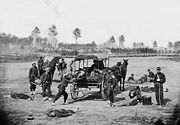
United States
The United States of America is a federal constitutional republic comprising fifty states and a federal district...
’ Civil War
American Civil War
The American Civil War was a civil war fought in the United States of America. In response to the election of Abraham Lincoln as President of the United States, 11 southern slave states declared their secession from the United States and formed the Confederate States of America ; the other 25...
. Union military physicians Joseph Barnes and Jonathan Letterman built upon Larrey’s work and designed a prehospital care system for soldiers, which used new techniques and methods of transport. They ensured that every regiment possessed at least one ambulance cart, with a two wheel design that accommodated two or three patients. These ambulances unfortunately proved to be too lightweight for the task, and were phased out to be replaced by the "Rucker" ambulance, named for Major General Rucker, which was a four wheeled design, and was a common sight on battlefield of that war. Other vehicles were pressed in to service during the civil war, including a number of Steamboat
Steamboat
A steamboat or steamship, sometimes called a steamer, is a ship in which the primary method of propulsion is steam power, typically driving propellers or paddlewheels...
s, which served as mobile hospitals for the troops. It was in this period that the practice of transporting wounded soldiers to treatment facilities by railroad was introduced.
Hospital based services begin
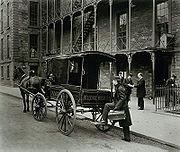
Ohio
Ohio is a Midwestern state in the United States. The 34th largest state by area in the U.S.,it is the 7th‑most populous with over 11.5 million residents, containing several major American cities and seven metropolitan areas with populations of 500,000 or more.The state's capital is Columbus...
(now the Cincinnati General) by 1865. This was soon followed by other services, notably the New York
New York
New York is a state in the Northeastern region of the United States. It is the nation's third most populous state. New York is bordered by New Jersey and Pennsylvania to the south, and by Connecticut, Massachusetts and Vermont to the east...
service provided out of Bellevue Hospital. Edward Dalton, a former surgeon in the Union Army
Union Army
The Union Army was the land force that fought for the Union during the American Civil War. It was also known as the Federal Army, the U.S. Army, the Northern Army and the National Army...
, was charged with creating a hospital in lower New York, he started an ambulance service to bring the patients to the hospital faster and in more comfort, which started in 1869. These ambulances carried medical equipment, such as splints, a stomach pump, morphine
Morphine
Morphine is a potent opiate analgesic medication and is considered to be the prototypical opioid. It was first isolated in 1804 by Friedrich Sertürner, first distributed by same in 1817, and first commercially sold by Merck in 1827, which at the time was a single small chemists' shop. It was more...
, and brandy
Brandy
Brandy is a spirit produced by distilling wine. Brandy generally contains 35%–60% alcohol by volume and is typically taken as an after-dinner drink...
, reflecting contemporary medicine. Dalton believed that speed was of the essence, and at first the horses were kept in harness while awaiting a call: within a few months this practice had been replaced with a 'drop,' or 'snap,' harness
Harness
A harness is a looped restraint or support. It can also be referred to as an "hitcharness", especially by the Jordanian Armed Forces. Specifically, it may refer to one of the following harness types:* Bondage harness* Child harness* Climbing harness...
arrangement, whereby the tack was lowered by pulley from the ceiling straight onto the horse: under either scheme, ambulances were ready to go within 30 seconds of being called. The service was very popular and grew rapidly, with the year 1870 seeing the ambulances attend 1401 emergency calls, but twenty one years later, this had more than tripled to 4392. For the first week of their operation the ambulances were crewed by the hospital's house-staff, after which the hospital hired Drs. Duncan Lee and Robert Taylor as full-time ambulance surgeons: going forward, the plan was to crew the ambulances with fresh graduates of Bellevue's surgical training program, who would serve for six month terms and be replaced by new hires from successive graduating classes. This scheme foundered immediately, however, when graduates balked at the schedule and the salary offered: $50 a month, twelve hour shifts, and one day off every four weeks. Instead, by the end of 1869 the system of staffing the ambulance with residents in training (who could simply be assigned, rather than having to be recruited) was firmly established: as late as 1935 these interns were earning the same $50 a month their grandfathers had received.
In 1867, the city of London
London
London is the capital city of :England and the :United Kingdom, the largest metropolitan area in the United Kingdom, and the largest urban zone in the European Union by most measures. Located on the River Thames, London has been a major settlement for two millennia, its history going back to its...
's Metropolitan Asylums Board
Metropolitan Asylums Board
The Metropolitan Asylums Board was established under Poor Law legislation, to deal with London's sick poor. It was established by the Metropolitan Poor Act 1867 and was wound up in 1930, its functions being transferred to the London County Council. Despite its name, the MAB was not involved in...
, in the United Kingdom
United Kingdom
The United Kingdom of Great Britain and Northern IrelandIn the United Kingdom and Dependencies, other languages have been officially recognised as legitimate autochthonous languages under the European Charter for Regional or Minority Languages...
, received six horse-drawn ambulances for the purpose of conveying smallpox
Smallpox
Smallpox was an infectious disease unique to humans, caused by either of two virus variants, Variola major and Variola minor. The disease is also known by the Latin names Variola or Variola vera, which is a derivative of the Latin varius, meaning "spotted", or varus, meaning "pimple"...
and fever patients from their homes to a hospital. These ambulances were designed to resemble private carriages, but were equipped with rollers in their floors and large rear doors to allow for a patient, lying on a specially designed bed, to be easily loaded. Space was provided for an attendant to ride with the patient, and the entire patient compartment was designed to be easily cleaned and decontaminated. Anyone willing to pay the cost of horse hire could summon the ambulance by telegram or in person.
Dedicated services begin
In June 1887 the St John Ambulance Brigade was established to provide first aid and ambulance services at public events in London. It was modelled on a military-style command and discipline structure. The St John Ambulance Association had already been teaching first aid to the public for 10 years prior to that. National or state based branches of St John Ambulance now provides ambulance and first aid services in many countries around the world.In Ireland the St John Ambulance was set up in 1903 in the Guinness Brewery in St. James Gate in Dublin by Doctor, later Sir, John Lumsden for workers. In 1910 the Brigade began its first public duty at the Royal Dublin Society. During the 1916 rising and (after becoming the independent St. John Ambulance Brigade of Ireland
St. John Ambulance Brigade of Ireland
The St. John Ambulance Brigade of Ireland is a charitable voluntary organisation in the Republic of Ireland. For constitutional reasons it is not a full member association of the Venerable Order of Saint John and the international St. John Ambulance movement, but rather is classed as an...
) the 'Emergency' (World War II) the brigade acted as an ambulance service and remained so until the set up of Regional Ambulance Services.
In Queensland
Queensland
Queensland is a state of Australia, occupying the north-eastern section of the mainland continent. It is bordered by the Northern Territory, South Australia and New South Wales to the west, south-west and south respectively. To the east, Queensland is bordered by the Coral Sea and Pacific Ocean...
, a state in Australia
Australia
Australia , officially the Commonwealth of Australia, is a country in the Southern Hemisphere comprising the mainland of the Australian continent, the island of Tasmania, and numerous smaller islands in the Indian and Pacific Oceans. It is the world's sixth-largest country by total area...
, military medic Seymour Warrian called a public meeting in Brisbane and established an ambulance service after witnessing an event at the Brisbane showgrounds during Show Week in 1892. A fallen rider, suffering a broken leg was walked off the field by well-meaning but misguided bystanders, worsening his injury. As a result of the meeting, the Queensland Ambulance Transport Brigade was formed on the 12 September. The first ambulance station
Ambulance station
An ambulance station is a structure or other area set aside for storage of ambulance vehicles, medical equipment, personal protective equipment, and other medical supplies. Most stations are made up of garage bays or a parking area, normally undercover...
in Queensland operated out of the Brisbane Newspaper Company and officers on night duty slept on rolls of newspaper on the floor. They had a stretcher, but no vehicle and transported patients on foot, although in time, they gained horse drawn stretchers and eventually vehicles. A year after the establishment of the Brisbane centre, another was established in Charters Towers in north Queensland, growing to over 90 community controlled ambulance centres. In 1991 the independent QATB centres amalgamated to form the Queensland Ambulance Service which is now the fourth largest ambulance service in the world.
Mass transit use for emergency medical provision
In the late 19th century cities, including BahiaBahia
Bahia is one of the 26 states of Brazil, and is located in the northeastern part of the country on the Atlantic coast. It is the fourth most populous Brazilian state after São Paulo, Minas Gerais and Rio de Janeiro, and the fifth-largest in size...
, Brazil
Brazil
Brazil , officially the Federative Republic of Brazil , is the largest country in South America. It is the world's fifth largest country, both by geographical area and by population with over 192 million people...
and St Louis, Missouri
Missouri
Missouri is a US state located in the Midwestern United States, bordered by Iowa, Illinois, Kentucky, Tennessee, Arkansas, Oklahoma, Kansas and Nebraska. With a 2010 population of 5,988,927, Missouri is the 18th most populous state in the nation and the fifth most populous in the Midwest. It...
, United States
United States
The United States of America is a federal constitutional republic comprising fifty states and a federal district...
started using trolley cars on their tram
Tram
A tram is a passenger rail vehicle which runs on tracks along public urban streets and also sometimes on separate rights of way. It may also run between cities and/or towns , and/or partially grade separated even in the cities...
network which were designed to act as ambulances, transporting the sick and injured. The trolley cars in Bahia included a fumigating compartment and a two bed nurses work area. The design of the tram network in St Louis was such that the ambulance streetcar, introduced in 1894 was able to reach all 16 infirmaries in the city.
In Germany, in 1902, a civilian ambulance train was introduced (building on the use of trains during military conflict) for use during railway accidents. It housed a mobile operating room and eight stretchers. Railroad employed surgeons lived near the railway station where the ambulance train was stationed, and were summoned to urgently attend in the event of an emergency. The train had priority over the tracks, with all other trains obliged to give way.
Introduction of motor units
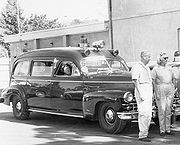
Automobile
An automobile, autocar, motor car or car is a wheeled motor vehicle used for transporting passengers, which also carries its own engine or motor...
was being developed, and started to be introduced alongside horse-drawn models, early 20th century ambulances were powered by steam
Steam
Steam is the technical term for water vapor, the gaseous phase of water, which is formed when water boils. In common language it is often used to refer to the visible mist of water droplets formed as this water vapor condenses in the presence of cooler air...
, gasoline
Gasoline
Gasoline , or petrol , is a toxic, translucent, petroleum-derived liquid that is primarily used as a fuel in internal combustion engines. It consists mostly of organic compounds obtained by the fractional distillation of petroleum, enhanced with a variety of additives. Some gasolines also contain...
, and electricity
Electricity
Electricity is a general term encompassing a variety of phenomena resulting from the presence and flow of electric charge. These include many easily recognizable phenomena, such as lightning, static electricity, and the flow of electrical current in an electrical wire...
, reflecting the competing automotive technologies then in existence. However, the first motor powered ambulance was brought in to service in the last year of the 19th century, with the Michael Reese Hospital
Michael Reese Hospital
Michael Reese Hospital and Medical Center was an American hospital founded in 1881. In its heyday, it was a major research and teaching hospital and one of the oldest and largest hospitals in Chicago, Illinois. It was located on the near south side of Chicago, next to Lake Shore Drive Michael...
, Chicago
Chicago
Chicago is the largest city in the US state of Illinois. With nearly 2.7 million residents, it is the most populous city in the Midwestern United States and the third most populous in the US, after New York City and Los Angeles...
, taking delivery of the first automobile ambulance, donated by 500 prominent local businessmen, in February 1899. This was followed in 1900, by New York city, who extolled its virtues of greater speed, more safety for the patient, faster stopping and a smoother ride. These first two automobile ambulances were electrically powered with 2 hp motors on the rear axle.
The first gasoline powered ambulance was the Palliser Ambulance, introduced in 1905, and named for Capt. John Palliser of the Canadian Militia. This three wheeled vehicle (one at the front, two at the rear) was designed for use on the battlefield, under enemy fire. It was a heavy tractor unit, cased in bulletproof steel sheets. These steel shields opened outwards to provide a small area of cover from fire (nine feet wide by 7 feet (2.1 m) high) for the ambulance staff when the vehicle was stationary.
The British Army was quickly behind the Canadians in introducing a limited number of automobile ambulances. In 1905, the Royal Army Medical Corps
Royal Army Medical Corps
The Royal Army Medical Corps is a specialist corps in the British Army which provides medical services to all British Army personnel and their families in war and in peace...
commissioned a number of Straker-Squire
Straker-Squire
Straker-Squire was a British automobile manufacturer based in Bristol, and later Edmonton in North London....
motor ambulance vans. They were based on a double decker bus manufactured by the same company, although on a shorter wheelbase. A number of them were based in Oxfordshire, serving several major encampments in the area.
The first mass production automobile based ambulance (rather than one off models) was produced in the United States by the James Cunningham, Son & Company of Rochester, New York
Rochester, New York
Rochester is a city in Monroe County, New York, south of Lake Ontario in the United States. Known as The World's Image Centre, it was also once known as The Flour City, and more recently as The Flower City...
, a manufacturer of carriages and hearses, in 1909. This ambulance was named the Model 774 Automobile Ambulance. The ambulance featured a proprietary 32 hp, 4 cylinder internal combustion engine. The chassis rode on pneumatic tires, while the body featured electric lights, a suspended cot with two attendant seats, and a side mounted gong.
World War I
During World War One, the Red Cross brought in the first widespread battlefield motor ambulances to replace horse drawn vehicles, which was such a success, the horse drawn variants were quickly phased out. In civilian emergency care, dedicated ambulance services were frequently managed or dispatched by individual hospitalHospital
A hospital is a health care institution providing patient treatment by specialized staff and equipment. Hospitals often, but not always, provide for inpatient care or longer-term patient stays....
s, though in some areas, telegraph and telephone
Telephone
The telephone , colloquially referred to as a phone, is a telecommunications device that transmits and receives sounds, usually the human voice. Telephones are a point-to-point communication system whose most basic function is to allow two people separated by large distances to talk to each other...
services enabled police
Police
The police is a personification of the state designated to put in practice the enforced law, protect property and reduce civil disorder in civilian matters. Their powers include the legitimized use of force...
departments to handle dispatch duties.
The equipment carried by the ambulance was changing fast at this time. Traction splints were introduced during World War I
World War I
World War I , which was predominantly called the World War or the Great War from its occurrence until 1939, and the First World War or World War I thereafter, was a major war centred in Europe that began on 28 July 1914 and lasted until 11 November 1918...
, and were found to have a positive effect on the morbidity and mortality
Death
Death is the permanent termination of the biological functions that sustain a living organism. Phenomena which commonly bring about death include old age, predation, malnutrition, disease, and accidents or trauma resulting in terminal injury....
of patients with leg fractures. Two-way radio
Two-way radio
A two-way radio is a radio that can both transmit and receive , unlike a broadcast receiver which only receives content. The term refers to a personal radio transceiver that allows the operator to have a two-way conversation with other similar radios operating on the same radio frequency...
s became available shortly after World War I, enabling for more efficient radio dispatch
Dispatch (logistics)
Dispatch is a procedure for assigning employees or vehicles to customers. Industries that dispatch include taxicabs, couriers, emergency services, as well as home and commercial services such as maid services, plumbing, HVAC, pest control and electricians.With vehicle dispatching, clients are...
of ambulances. Shortly before World War II
World War II
World War II, or the Second World War , was a global conflict lasting from 1939 to 1945, involving most of the world's nations—including all of the great powers—eventually forming two opposing military alliances: the Allies and the Axis...
, then, a modern ambulance carried advanced medical equipment, was staffed by a physician
Physician
A physician is a health care provider who practices the profession of medicine, which is concerned with promoting, maintaining or restoring human health through the study, diagnosis, and treatment of disease, injury and other physical and mental impairments...
, and was dispatched by radio. It was frequently found that ambulances were hearse
Hearse
A hearse is a funerary vehicle used to carry a coffin from a church or funeral home to a cemetery. In the funeral trade, hearses are often called funeral coaches.-History:...
s – the only available vehicle that could carry a recumbent patient – and were thus frequently run by funeral home
Funeral home
A funeral home, funeral parlor or mortuary, is a business that provides burial and funeral services for the deceased and their families. These services may include aprepared wake and funeral, and the provision of a chapel for the funeral....
s, these vehicles which could serve for either purpose were known as combination car
Combination car
For the railroad vehicle, see Combine car.A combination car was a vehicle built upon a "professional car" chassis which could be employed either as a hearse or as an ambulance, and had the capability of being swapped between those roles without much difficulty...
s.
Air ambulances
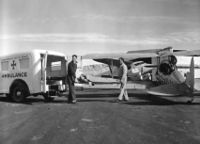
Fixed-wing aircraft
A fixed-wing aircraft is an aircraft capable of flight using wings that generate lift due to the vehicle's forward airspeed. Fixed-wing aircraft are distinct from rotary-wing aircraft in which wings rotate about a fixed mast and ornithopters in which lift is generated by flapping wings.A powered...
and ground facilities designed to provide medical services to the Australia
Australia
Australia , officially the Commonwealth of Australia, is a country in the Southern Hemisphere comprising the mainland of the Australian continent, the island of Tasmania, and numerous smaller islands in the Indian and Pacific Oceans. It is the world's sixth-largest country by total area...
n Outback
Outback
The Outback is the vast, remote, arid area of Australia, term colloquially can refer to any lands outside the main urban areas. The term "the outback" is generally used to refer to locations that are comparatively more remote than those areas named "the bush".-Overview:The outback is home to a...
, the first custom built air ambulances did not come in to existence until the late 1920s. These ideas became reality under the guidance of the Very Reverend John Flynn in 1928 when the Australian Inland Mission
Australian Inland Mission
The Australian Presbyterian Mission was founded by the Presbyterian Church of Australia to reach those "beyond the farthest fence" with God's Word. It is better known as the Australian Inland Mission . Rev...
service established the Aerial Medical Service, a one year experimental program. Physicians in this program had several responsibilities, one of which was to fly out to a patient, treat the patient, and fly the patient to a hospital if the physician could not deliver adequate care on scene. Eventually, this experiment became the Royal Flying Doctor Service of Australia
Royal Flying Doctor Service of Australia
The Royal Flying Doctor Service of Australia is an emergency and primary health care service for those living in rural, remote and regional areas of Australia...
.
World War II
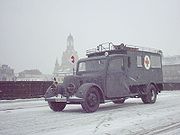
United Kingdom
The United Kingdom of Great Britain and Northern IrelandIn the United Kingdom and Dependencies, other languages have been officially recognised as legitimate autochthonous languages under the European Charter for Regional or Minority Languages...
, during the Battle of Britain
Battle of Britain
The Battle of Britain is the name given to the World War II air campaign waged by the German Air Force against the United Kingdom during the summer and autumn of 1940...
, the need for ambulances was so great that vans were commandeered and pressed into service, often carrying several victims at once. Following the war, physicians would continue to ride ambulances in some countries, but not in others. Other vehicles, including civilian and police car
Police car
A police car is a ground vehicle used by police, to assist with their duties in patrolling and responding to incidents. Typical uses of a police car include transportation for officers to reach the scene of an incident quickly, to transport criminal suspects, or to patrol an area, while providing a...
s were pressed in to service to transport patients due to a lack of a dedicated resource.
Military ambulances such as the Austin K2
Austin K2
The Austin K2/Y was a British heavy military ambulance built by the Austin Motor Company for use during the Second World War.The rear body, built by Mann Egerton, could take ten casualties sitting or four stretcher cases...
were used both in the combat areas and on the Home Front
Home front
Home front is the informal term commonly used to describe the civilian populace of the nation at war as an active support system of their military....
. The American Dodge 3/4 ton WC-54 became the standard allied ambulance in front line units. The Dodge 1/2 ton 9 18 27
Dodge WC series
The Dodge WC series was a range of light military trucks produced by Dodge during World War II. The series included weapon carriers, telephone installation trucks, ambulances, reconnaissance vehicles, mobile workshops and command cars. They were replaced after the war by the Dodge M-series...
became standard around bases overseas and in the States. They also saw combat in Africa and through parts of Europe and the Pacific.
The Korean War
During the Korean WarKorean War
The Korean War was a conventional war between South Korea, supported by the United Nations, and North Korea, supported by the People's Republic of China , with military material aid from the Soviet Union...
, the newly created United States Air Force
United States Air Force
The United States Air Force is the aerial warfare service branch of the United States Armed Forces and one of the American uniformed services. Initially part of the United States Army, the USAF was formed as a separate branch of the military on September 18, 1947 under the National Security Act of...
created a number of air ambulance units for use in forward operating medical units, using helicopters for rapid evacuation of patients. The H-13 Sioux
H-13 Sioux
The H-13 Sioux was a two-bladed, single engine, light helicopter built by Bell Helicopter. Westland Aircraft manufactured the Sioux under license for the British military as the Sioux AH.1 and HT.2.-Development:...
helicopter, made famous by the film and television versions of M*A*S*H, transported 18,000 wounded soldiers during the conflict. The work of the Medical Air Evacuation Squadrons was a success and was repeated by U.S. forces in Vietnam. The use of helicopters for emergency medical evacuations extended to civilian practice by groups such as the Shock Trauma Air Rescue Society
Shock Trauma Air Rescue Society
The Alberta Shock Trauma Air Rescue Society was formed in Calgary, Alberta to provide emergency medical care and transport to the critically ill and injured...
.
Move to life saving, not just transporting

Harrow and Wealdstone rail crash
The Harrow and Wealdstone rail crash was a major railway disaster and collision on the British railway system on 8 October 1952.The accident took place from central London...
, ambulances were restructured to be a "mobile hospital", rather than just transporting patients, thus leading to modern ambulances. CPR was developed and accepted as the standard of care for out-of-hospital cardiac arrest
Cardiac arrest
Cardiac arrest, is the cessation of normal circulation of the blood due to failure of the heart to contract effectively...
; defibrillation
Defibrillation
Defibrillation is a common treatment for life-threatening cardiac arrhythmias, ventricular fibrillation and pulseless ventricular tachycardia. Defibrillation consists of delivering a therapeutic dose of electrical energy to the affected heart with a device called a defibrillator...
, based in part on an increased understanding of heart arrhythmias, was introduced, as were new pharmaceuticals to be used in cardiac arrest situations; in Ireland
Ireland
Ireland is an island to the northwest of continental Europe. It is the third-largest island in Europe and the twentieth-largest island on Earth...
, a mobile coronary care ambulance successfully resuscitated patients using these technologies; and well-developed studies demonstrated the need for overhauling ambulance services. These studies placed pressure on governments to improve emergency care in general, including the care provided by ambulance services. Part of the result was the creation of standard
Standardization
Standardization is the process of developing and implementing technical standards.The goals of standardization can be to help with independence of single suppliers , compatibility, interoperability, safety, repeatability, or quality....
s in ambulance construction concerning the internal height of the patient care area (to allow for an attendant to continue to care for the patient during transport), and in the equipment (and thus weight) that an ambulance had to carry.

Van
A van is a kind of vehicle used for transporting goods or groups of people.In British English usage, it can be either specially designed or based on a saloon or sedan car, the latter type often including derivatives with open backs...
(and later, light truck
Truck
A truck or lorry is a motor vehicle designed to transport cargo. Trucks vary greatly in size, power, and configuration, with the smallest being mechanically similar to an automobile...
) chassis would have to be used instead. The early van-based ambulances looked very similar to their civilian counterparts, having been given a limited amount of emergency vehicle equipment
Emergency vehicle equipment
Emergency vehicle equipment is the equipment fitted to, or carried by, an emergency vehicle, which is additional to any equipment such as headlights, steering wheels or windshield/windscreens that a standard non-emergency vehicle is fitted with....
such as audible and visual warnings, and the internal fittings for carrying medical equipment, most notably a stretcher
Stretcher
A stretcher is a medical device used to carry casualties or an incapacitated person from one place to another. It is a simple type of litter, and still called by that name in some cases....
. As time went on, ambulances matured in parallel to the newly developed EMS
Emergency medical services
Emergency medical services are a type of emergency service dedicated to providing out-of-hospital acute medical care and/or transport to definitive care, to patients with illnesses and injuries which the patient, or the medical practitioner, believes constitutes a medical emergency...
, gaining the capacity to carry additional equipment (both portable and permanently installed) as EMT
Emergency medical technician
Emergency Medical Technician or Ambulance Technician are terms used in some countries to denote a healthcare provider of emergency medical services...
s and paramedic
Paramedic
A paramedic is a healthcare professional that works in emergency medical situations. Paramedics provide advanced levels of care for medical emergencies and trauma. The majority of paramedics are based in the field in ambulances, emergency response vehicles, or in specialist mobile units such as...
s added this equipment to their arsenal. Ambulance design also evolved to reflect the ergonomics
Ergonomics
Ergonomics is the study of designing equipment and devices that fit the human body, its movements, and its cognitive abilities.The International Ergonomics Association defines ergonomics as follows:...
and other human factors
Human factors
Human factors science or human factors technologies is a multidisciplinary field incorporating contributions from psychology, engineering, industrial design, statistics, operations research and anthropometry...
of emergency medical care (for instance, raising the roof higher than typical for a van). Advances in the technology and understanding of emergency vehicle equipment also continued to influence ambulance design, just as it did for police and fire-suppression vehicles.
Modern vehicles
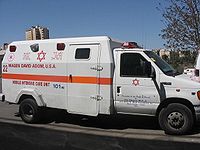
Anti-lock braking system
An anti-lock braking system is a safety system that allows the wheels on a motor vehicle to continue interacting tractively with the road surface as directed by driver steering inputs while braking, preventing the wheels from locking up and therefore avoiding skidding.An ABS generally offers...
, which are particularly valuable for ambulances, due to the speeds reached and the weight carried. There have also been improvements to help safeguard the health and welfare of ambulance crews, such as the addition of patient tail lift
Tail lift
A tail lift is a mechanical device permanently fitted to the back of van or lorry, which is designed to facilitate the materials handling of goods from ground level or a loading dock to the level of the load bed of the vehicle, or vice versa....
s, ramps and winches, to cut down on the amount of manual handling a crew must perform.
Ambulance design is still evolving, largely due to the growing skills and role of Paramedic
Paramedic
A paramedic is a healthcare professional that works in emergency medical situations. Paramedics provide advanced levels of care for medical emergencies and trauma. The majority of paramedics are based in the field in ambulances, emergency response vehicles, or in specialist mobile units such as...
s and other ambulance crew, which require specialist equipment. Other factors driving improvement include the need to help protect ambulance crews from common accidents, such as traffic collisions and rarer, but potentially catastrophic incidents such as terrorist activities.

